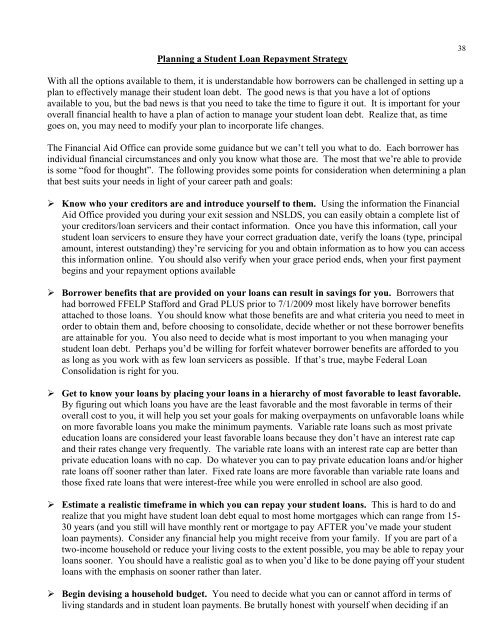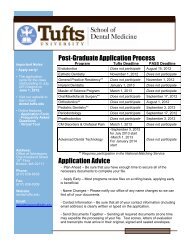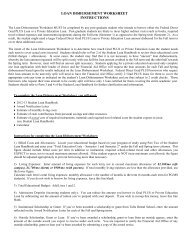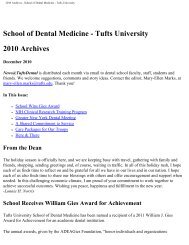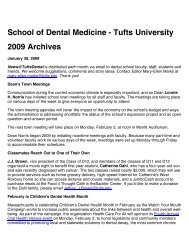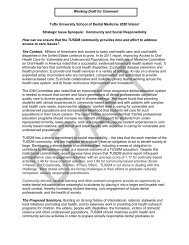student loan repayment manual table of contents - Tufts University
student loan repayment manual table of contents - Tufts University
student loan repayment manual table of contents - Tufts University
Create successful ePaper yourself
Turn your PDF publications into a flip-book with our unique Google optimized e-Paper software.
Planning a Student Loan Repayment Strategy38With all the options available to them, it is understandable how borrowers can be challenged in setting up aplan to effectively manage their <strong>student</strong> <strong>loan</strong> debt. The good news is that you have a lot <strong>of</strong> optionsavailable to you, but the bad news is that you need to take the time to figure it out. It is important for youroverall financial health to have a plan <strong>of</strong> action to manage your <strong>student</strong> <strong>loan</strong> debt. Realize that, as timegoes on, you may need to modify your plan to incorporate life changes.The Financial Aid Office can provide some guidance but we can’t tell you what to do. Each borrower hasindividual financial circumstances and only you know what those are. The most that we’re able to provideis some “food for thought”. The following provides some points for consideration when determining a planthat best suits your needs in light <strong>of</strong> your career path and goals:‣ Know who your creditors are and introduce yourself to them. Using the information the FinancialAid Office provided you during your exit session and NSLDS, you can easily obtain a complete list <strong>of</strong>your creditors/<strong>loan</strong> servicers and their contact information. Once you have this information, call your<strong>student</strong> <strong>loan</strong> servicers to ensure they have your correct graduation date, verify the <strong>loan</strong>s (type, principalamount, interest outstanding) they’re servicing for you and obtain information as to how you can accessthis information online. You should also verify when your grace period ends, when your first paymentbegins and your <strong>repayment</strong> options available‣ Borrower benefits that are provided on your <strong>loan</strong>s can result in savings for you. Borrowers thathad borrowed FFELP Stafford and Grad PLUS prior to 7/1/2009 most likely have borrower benefitsattached to those <strong>loan</strong>s. You should know what those benefits are and what criteria you need to meet inorder to obtain them and, before choosing to consolidate, decide whether or not these borrower benefitsare attainable for you. You also need to decide what is most important to you when managing your<strong>student</strong> <strong>loan</strong> debt. Perhaps you’d be willing for forfeit whatever borrower benefits are afforded to youas long as you work with as few <strong>loan</strong> servicers as possible. If that’s true, maybe Federal LoanConsolidation is right for you.‣ Get to know your <strong>loan</strong>s by placing your <strong>loan</strong>s in a hierarchy <strong>of</strong> most favorable to least favorable.By figuring out which <strong>loan</strong>s you have are the least favorable and the most favorable in terms <strong>of</strong> theiroverall cost to you, it will help you set your goals for making overpayments on unfavorable <strong>loan</strong>s whileon more favorable <strong>loan</strong>s you make the minimum payments. Variable rate <strong>loan</strong>s such as most privateeducation <strong>loan</strong>s are considered your least favorable <strong>loan</strong>s because they don’t have an interest rate capand their rates change very frequently. The variable rate <strong>loan</strong>s with an interest rate cap are better thanprivate education <strong>loan</strong>s with no cap. Do whatever you can to pay private education <strong>loan</strong>s and/or higherrate <strong>loan</strong>s <strong>of</strong>f sooner rather than later. Fixed rate <strong>loan</strong>s are more favorable than variable rate <strong>loan</strong>s andthose fixed rate <strong>loan</strong>s that were interest-free while you were enrolled in school are also good.‣ Estimate a realistic timeframe in which you can repay your <strong>student</strong> <strong>loan</strong>s. This is hard to do andrealize that you might have <strong>student</strong> <strong>loan</strong> debt equal to most home mortgages which can range from 15-30 years (and you still will have monthly rent or mortgage to pay AFTER you’ve made your <strong>student</strong><strong>loan</strong> payments). Consider any financial help you might receive from your family. If you are part <strong>of</strong> atwo-income household or reduce your living costs to the extent possible, you may be able to repay your<strong>loan</strong>s sooner. You should have a realistic goal as to when you’d like to be done paying <strong>of</strong>f your <strong>student</strong><strong>loan</strong>s with the emphasis on sooner rather than later.‣ Begin devising a household budget. You need to decide what you can or cannot afford in terms <strong>of</strong>living standards and in <strong>student</strong> <strong>loan</strong> payments. Be brutally honest with yourself when deciding if an


